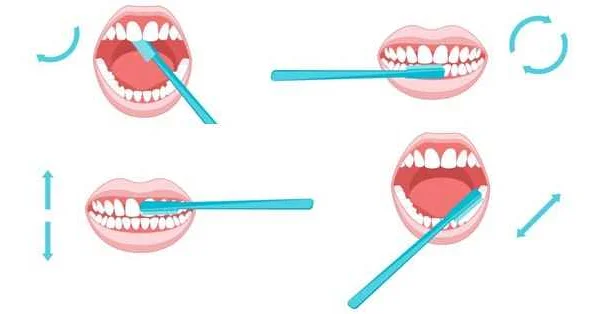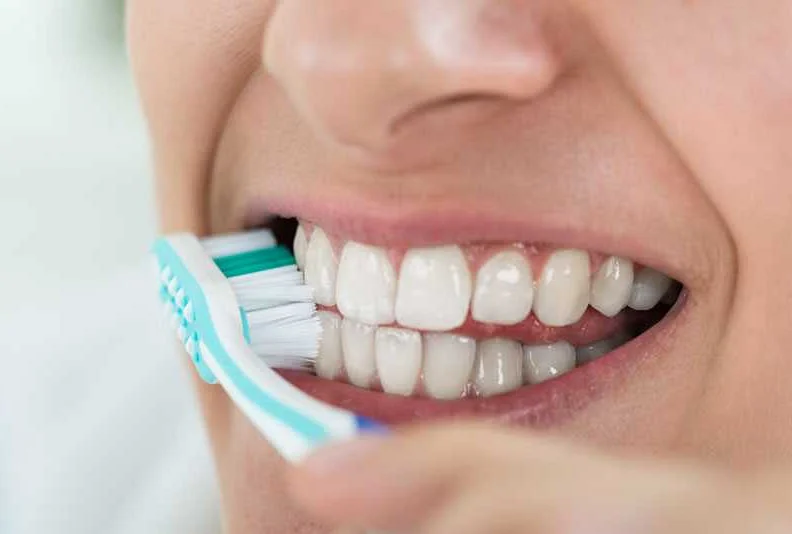How to Brush Your Teeth Properly
Содержимое
Learn the correct technique for brushing your teeth to maintain optimal oral health. Find out the best toothbrush and toothpaste, and how often you should brush your teeth for the best results.
Brushing your teeth is an essential part of maintaining good oral hygiene. However, simply brushing your teeth isn’t enough; you need to know the correct technique to ensure that you are effectively removing plaque and preventing tooth decay and gum disease.
First and foremost, it’s important to choose the right toothbrush. Opt for a soft-bristled brush that is comfortable to hold. Hard-bristled brushes can damage your gums and tooth enamel. Additionally, consider using an electric toothbrush, as it can provide more effective cleaning.
Next, it’s crucial to brush your teeth at least twice a day for two minutes each time. Be sure to brush all surfaces of your teeth, including the front, back, and chewing surfaces. Use short, gentle strokes and hold the brush at a 45-degree angle to your gums. This helps to remove plaque and food particles while avoiding unnecessary pressure on your teeth.
Remember to pay attention to your technique while brushing. Avoid scrubbing your teeth too hard, as this can lead to gum recession and tooth sensitivity. Instead, use a gentle circular or back-and-forth motion to clean your teeth effectively.
In addition to brushing, don’t forget to floss and use mouthwash regularly. Flossing helps to remove plaque and debris from between your teeth and along the gumline, while mouthwash can rinse away bacteria and freshen your breath.
By following these guidelines and maintaining a consistent oral hygiene routine, you can keep your teeth and gums healthy and prevent common dental problems. Don’t underestimate the power of correct brushing technique – it’s the foundation of a beautiful and healthy smile!
The Importance of Oral Hygiene
Oral hygiene plays a crucial role in maintaining overall oral health and preventing various dental issues. Good oral hygiene practices, such as regular brushing and flossing, help to remove plaque and food debris from the mouth, preventing the formation of tooth decay and gum disease.
When plaque and bacteria build up on the teeth and gums, they can cause a number of problems, including cavities, gum inflammation, and bad breath. Over time, these issues can worsen and lead to more serious conditions, such as periodontitis, which can result in tooth loss and even impact overall health.
Regular brushing, at least twice a day, using a fluoride toothpaste, along with daily flossing, can help to remove plaque and bacteria from the teeth and gumline. It is recommended to use a soft-bristled toothbrush to prevent damage to the tooth enamel and gums. Additionally, using an antimicrobial mouthwash can provide extra protection against bacteria.
In addition to preventing dental issues, proper oral hygiene also promotes a healthy and attractive smile. It helps to keep teeth clean, white, and free from discoloration and stains. Brushing and flossing also contribute to fresh breath, enhancing overall self-confidence and social interactions.
| Prevents tooth decay and gum disease |
| Reduces the risk of cavities |
| Prevents bad breath |
| Improves overall oral health |
| Promotes a healthy and attractive smile |
It is important to visit a dentist regularly, at least twice a year, for professional cleanings and check-ups. A dentist can identify any oral health issues and provide necessary treatments or recommendations for maintaining optimal oral hygiene.
In conclusion, practicing good oral hygiene is essential for maintaining healthy teeth and gums, preventing dental issues, and promoting overall oral health. By following a proper brushing and flossing routine, along with regular dental visits, individuals can enjoy a beautiful smile and a lifetime of oral wellness.
Why Brushing Your Teeth is Important

Brushing your teeth is an essential part of maintaining good oral hygiene. It helps to remove plaque and bacteria that can lead to tooth decay, gum disease, and bad breath. Regular brushing can also help to prevent cavities and keep your teeth and gums healthy.
When you brush your teeth, you remove the sticky film of bacteria, called plaque, that forms on your teeth. If plaque is not removed, it can harden into tartar, which can only be removed by a dental professional. Tartar can cause gum disease and can lead to tooth loss if left untreated.
Brushing your teeth also helps to stimulate your gums and keep them healthy. By brushing, you help to increase blood flow to the gums, which can prevent gum disease and keep your gums strong and protected.
In addition to preventing tooth decay and gum disease, brushing your teeth can also help to keep your breath fresh. Bad breath is often caused by bacteria in the mouth, and regular brushing can help to remove these bacteria and keep your breath smelling fresh.
To get the most benefit from brushing your teeth, it is important to use the correct technique. You should brush your teeth at least twice a day for two minutes each time. Use a soft-bristled toothbrush and toothpaste that contains fluoride. Brush in a circular motion, focusing on each tooth individually, and be sure to brush all surfaces of the teeth, including the front, back, and chewing surfaces.
Remember, brushing your teeth is not only important for your oral health but also for your overall well-being. A healthy mouth can contribute to a healthy body, so make sure to prioritize brushing your teeth as part of your daily routine.
Choosing the Right Toothbrush
When it comes to maintaining optimal oral hygiene, choosing the right toothbrush is essential. With so many options available on the market, it can be overwhelming to know which one to select. Here are some key factors to consider when choosing a toothbrush:
- Bristle Type: The bristles of a toothbrush come in various types, such as soft, medium, and hard. Dentists generally recommend using a toothbrush with soft bristles, as they are less likely to cause damage to the gums and tooth enamel.
- Head Size: The size of the toothbrush head is an important consideration. It should be small enough to comfortably fit in your mouth and reach all areas of your teeth, including the back molars.
- Handle Grip: The handle of the toothbrush should provide a comfortable grip, making it easy to control and maneuver while brushing. Look for a handle that feels comfortable in your hand and allows for proper control.
- Powered or Manual: Another decision to make is whether to choose a powered or manual toothbrush. Powered toothbrushes can provide additional cleaning power and make brushing easier for those with limited mobility. However, manual toothbrushes can be just as effective if used correctly.
- Replace Regularly: No matter which toothbrush you choose, it is important to replace it regularly. Dentists recommend getting a new toothbrush every three to four months or sooner if the bristles become frayed or worn.
By considering these factors, you can make an informed decision when selecting the right toothbrush for your oral hygiene routine. Remember to combine regular brushing with flossing and regular dental check-ups for optimal oral health.
The Correct Technique for Brushing Your Teeth

Brushing your teeth is an essential part of maintaining optimal oral hygiene. However, it is not enough to simply scrub your teeth with a toothbrush. To effectively clean your teeth and gums, it is important to use the correct brushing technique.
First, make sure to choose a toothbrush with soft bristles that can easily reach all areas of your mouth. Hard bristles can be too harsh on your gums and cause damage. Additionally, be sure to replace your toothbrush every three to four months or when the bristles become frayed.
Next, apply a pea-sized amount of fluoride toothpaste to your toothbrush. Fluoride helps strengthen tooth enamel and prevent tooth decay. Gently brush your teeth in a circular motion, focusing on each tooth individually. Pay close attention to the gum line, where plaque and bacteria can accumulate.
Make sure to brush all surfaces of your teeth, including the front, back, and chewing surfaces. Spend at least two minutes brushing your teeth to ensure a thorough clean. You can use a timer or play a song to help track the time.
In addition to brushing your teeth, it is important to clean your tongue as well. Use a tongue scraper or your toothbrush to gently remove bacteria and debris from your tongue. This can help prevent bad breath and improve overall oral health.
After brushing, rinse your mouth thoroughly with water to remove any remaining toothpaste or debris. Avoid rinsing with mouthwash immediately after brushing, as it can wash away the fluoride from the toothpaste. Wait at least 30 minutes before using mouthwash.
Finally, don’t forget to floss daily and visit your dentist regularly for professional cleanings and check-ups. Brushing alone cannot remove plaque and tartar from between your teeth and along the gum line.
By following these steps and using the correct brushing technique, you can maintain optimal oral hygiene and keep your teeth and gums healthy.
The Role of Toothpaste in Oral Hygiene
When it comes to maintaining optimal oral hygiene, one of the most important tools at your disposal is toothpaste. Toothpaste plays a crucial role in keeping your teeth and gums healthy and free from dental issues.
There are several key functions that toothpaste serves in oral hygiene:
- Removal of plaque: Toothpaste contains mild abrasives that help to remove plaque from the surfaces of your teeth. Plaque is a sticky film of bacteria that can build up on your teeth and gums and contribute to tooth decay and gum disease.
- Prevention of tooth decay: Most toothpaste contains fluoride, which is a mineral that helps to strengthen the enamel of your teeth and make them more resistant to tooth decay. Brushing your teeth with fluoride toothpaste can significantly reduce your risk of developing cavities.
- Protection against gum disease: Gum disease is a common oral health issue that can cause gum inflammation, bleeding, and even tooth loss if left untreated. Toothpaste with antibacterial properties can help to kill the bacteria that contribute to gum disease and keep your gums healthy.
- Fresh breath: Toothpaste often contains ingredients such as mint or other flavors that help to freshen your breath and leave your mouth feeling clean and refreshed.
It’s important to choose the right toothpaste for your needs. Look for toothpaste that is approved by dental professionals and contains fluoride. If you have specific dental concerns, such as sensitive teeth or gum disease, you may want to consider a specialized toothpaste that targets these issues.
Remember that toothpaste should be used in conjunction with regular brushing and flossing for optimal oral hygiene. Brush your teeth at least twice a day, for two minutes each time, and don’t forget to replace your toothbrush every three to four months for the best results.
By understanding the role of toothpaste in oral hygiene and using it effectively, you can take proactive steps to maintain a healthy and beautiful smile.